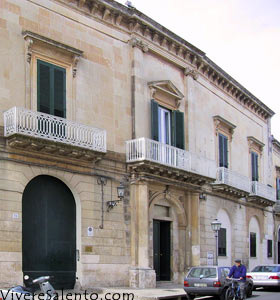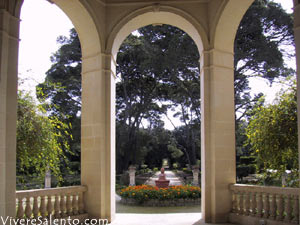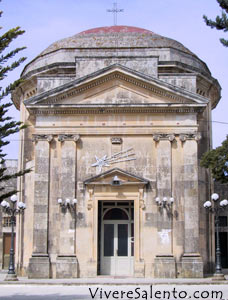|
|

| Inhabitants's name: Magliesi |
The civic coat of arms
of Maglie has a blue background and it represents three interwoven rings.
 There
are no historical documents about the origins of this small town but the
recovery of some megalithic monuments proves that man already lived on this
territory during the prehistoric age. The names of the menhirs are
"Crocemuzza", "Spruno", "Calamauri" and of the dolmens "Canali" and "Chianca".
The toponym derives from the Latin word "mallae mallearum" meaning "mesh". The
first village was probably founded around the IX century when the Greek, built
three towers in the three casali of St Egidio, St. Basilio and St. Vito
to defend themselves from the Saracens. After the unification of the three
neighbouring centres the new-born town was first called Magalia and then Maglie.
During the Greek domination the village was strengthened with other towers and
walls and when the Normans arrived, Maglie became an important centre of the
County of Lecce. In the XII century the king Tancredi of Altavilla gave the feud
to Evangelista Lubello. The Lubello family governed for four centuries until
1608. Later the feud There
are no historical documents about the origins of this small town but the
recovery of some megalithic monuments proves that man already lived on this
territory during the prehistoric age. The names of the menhirs are
"Crocemuzza", "Spruno", "Calamauri" and of the dolmens "Canali" and "Chianca".
The toponym derives from the Latin word "mallae mallearum" meaning "mesh". The
first village was probably founded around the IX century when the Greek, built
three towers in the three casali of St Egidio, St. Basilio and St. Vito
to defend themselves from the Saracens. After the unification of the three
neighbouring centres the new-born town was first called Magalia and then Maglie.
During the Greek domination the village was strengthened with other towers and
walls and when the Normans arrived, Maglie became an important centre of the
County of Lecce. In the XII century the king Tancredi of Altavilla gave the feud
to Evangelista Lubello. The Lubello family governed for four centuries until
1608. Later the feud passed under the control of Paolo Maresgallo. In 1686 Anna Carrera became the
new feudal vassal and she was succeeded by Nicola Prato and in 1711 by Ascanio
Filomarino, that ruled it until 1723. The last vassal was Francesco Capece that
acquired the centre for 43,500 dukedoms, and governed until 1806. The Capeces
contributed a lot to the economic and social prosperity of Maglie that became
one of the most important centres of the Salento. The baroness Francesca Capece
left all her fortune to the young people of Maglie to let them study. Here
there are several important local characters as Aldo Moro, who was born in
1916: he was a statesman and a politician. He taught at he universities of Rome
and Bari. Between 1955 and 1957 he was elected Lord Chancellor and then
Minister of the Education and Minister for Foreign
Affairs. He was first secretary and then president of
passed under the control of Paolo Maresgallo. In 1686 Anna Carrera became the
new feudal vassal and she was succeeded by Nicola Prato and in 1711 by Ascanio
Filomarino, that ruled it until 1723. The last vassal was Francesco Capece that
acquired the centre for 43,500 dukedoms, and governed until 1806. The Capeces
contributed a lot to the economic and social prosperity of Maglie that became
one of the most important centres of the Salento. The baroness Francesca Capece
left all her fortune to the young people of Maglie to let them study. Here
there are several important local characters as Aldo Moro, who was born in
1916: he was a statesman and a politician. He taught at he universities of Rome
and Bari. Between 1955 and 1957 he was elected Lord Chancellor and then
Minister of the Education and Minister for Foreign
Affairs. He was first secretary and then president of
 the
party of the Christian Democracy. He played an important role in the Italian
politics but he was murdered on May 10th in 1978, after being kidnapped for 55
days by the Red Brigades. Concetta Annesi was born in 1749 and she decided to
invest all her inheritance in the construction of an institute for poor girls,
that was built in 1854, some years after her death. Raffaele Fitto was born in
1941, and he was an important political man. After graduating at the University
of Bari in Economy and Commerce, he was elected mayor of Maglie, secretary of
the Regional Counsel and, finally, President of the Region. He died in 1988 when
he was 47 years old. Other well-known characters are:
Francesco Saverio Giannotta (he lived in the XIX and was appointed Member of
Parliament in 1848), Oronzo De Donno (obstetric of
the XVIII century), Giacinto Toma (judge and man of letters of XIX century),
Giacomo Piccinni (philosopher, theologian and archaeologist of the XVIII
century), Antonio Adamuccio (physician of the XVIII century), Oreste Macrì
(translator and man of letters of the XX century), Luigi Giannaccari (Latinist
of the XX century) and Francesco Negro (writer and poet of the XIX century). the
party of the Christian Democracy. He played an important role in the Italian
politics but he was murdered on May 10th in 1978, after being kidnapped for 55
days by the Red Brigades. Concetta Annesi was born in 1749 and she decided to
invest all her inheritance in the construction of an institute for poor girls,
that was built in 1854, some years after her death. Raffaele Fitto was born in
1941, and he was an important political man. After graduating at the University
of Bari in Economy and Commerce, he was elected mayor of Maglie, secretary of
the Regional Counsel and, finally, President of the Region. He died in 1988 when
he was 47 years old. Other well-known characters are:
Francesco Saverio Giannotta (he lived in the XIX and was appointed Member of
Parliament in 1848), Oronzo De Donno (obstetric of
the XVIII century), Giacinto Toma (judge and man of letters of XIX century),
Giacomo Piccinni (philosopher, theologian and archaeologist of the XVIII
century), Antonio Adamuccio (physician of the XVIII century), Oreste Macrì
(translator and man of letters of the XX century), Luigi Giannaccari (Latinist
of the XX century) and Francesco Negro (writer and poet of the XIX century).
|